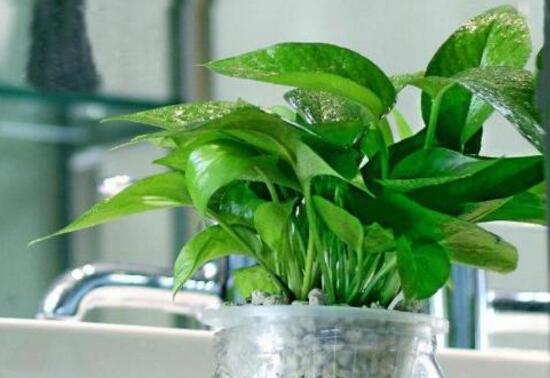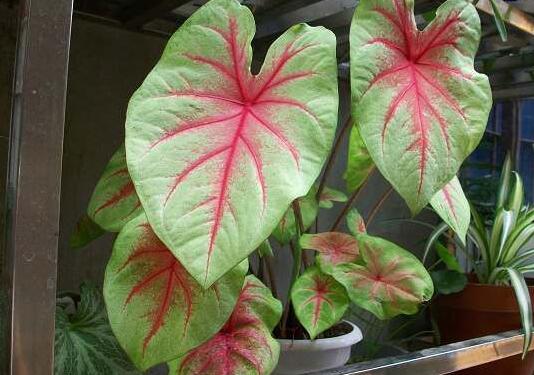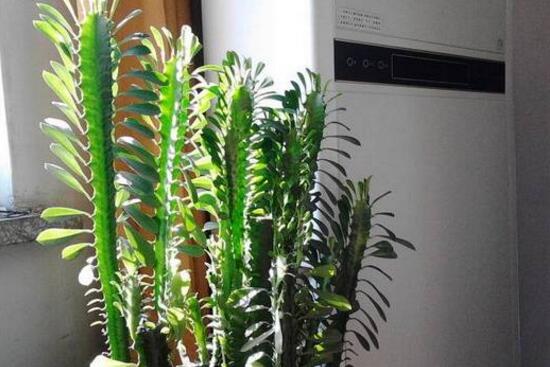Can green orchids be raised in water? green orchids can be raised in water / cut and inserted in a bottle.
For the green orchid, we must be no stranger, it can not only absorb formaldehyde, more importantly, the long beauty, the four seasons evergreen leaves, soft drooping, looking beautiful. Compared with soil culture, hydroponic plants will look more beautiful, can green orchids be raised in water? The following is the water culture method of green orchid, it is very simple, follow the editor to have a look.
Green orchids can be raised in water.

Green orchid like warm, humid environment, and cut a branch into the water, can survive, so green orchid can be raised in water? Obviously, it can, and this is also one of the cutting methods of green orchid. In life, many flower friends must want to cultivate green orchids in water. In order to make new flower friends know how to raise them, let's take a look at the methods of aquaculture.
2. the method of aquaculture of green orchid
Materials: scissors, beverage bottles (or other beautiful transparent containers), green apple hanging orchid
1. Cuttings selection
On the 1-2-year-old green orchid, a healthy, pest-free vine with air root was selected and cut off as cuttings with scissors. It can be cut into multiple strips, as shown in the figure.
2. Container selection
In the aquaculture method of green orchid, there are many choices of containers: if you are just cutting and playing, use a plastic bottle, but if you plan to keep it for a long time, it is best to prepare a beautiful transparent glass container.
3. Water plug begins
Pour water into the container so that the water surface is at 2/3 of the bottle. Then insert the cut green orchid cuttings so that the air root touches the water surface. After insertion, put the glass bottle in a ventilated, well-lit place where the sun is out of reach.
4. Water quality / water temperature
The water temperature is fine at room temperature, but if it is tap water, you need to put it in the sun two days in advance to remove chlorine from the tap water. Of course, cold boiled water is fine, no need to bask in the sun, just use it.
5. Rooting / maintenance
Green Luo hanging orchid aquaculture method, do a good job of the above steps, basically completed more than half, followed by daily maintenance. In about a week or so, the root of the air will grow. After waiting for the plant to survive completely, put it on the balcony to breed, should pay attention to often change water, keep the air moist.
Hydroponic culture and soil culture
If we just insert the water as a transition, then after the air root grows the root, it can be transplanted into the soil. Find a flowerpot, put the green roses with roots and hang orchid vines, and dish them into the soil. Then put it in a ventilated and ventilated place where there is astigmatism to avoid direct sunlight, watering should be dry and wet, watering should be thoroughly, and do not water sporadically or too much.
The function is similar to the difference in appearance the difference between big green pineapple and hanging orchid
Green pineapple and hanging orchid are ubiquitous household plants that can purify the air, but many people confuse green pineapple with hanging orchid. Because they are both green plants and easy to feed. So, is there any difference between green orchid and hanging orchid? Next, let's learn about it together.
Category
Green pineapple belongs to the rattan family and does not blossom. And the orchid belongs to the tequila family, which can open small flowers.
Stem
The main stem of green pineapple is relatively long, can be extended all the time, and is accompanied by green leaves, while the stem of Cymbidium is shorter and its leaves are longer.
Leaf
The difference between the leaves of green orchid and hanging orchid is more obvious, the leaf of green apple is oval, similar to the shape of the heart, and the leaf of hanging orchid is slender.
Growth direction
Green orchid is a climbing growth, the highest can grow to 20 meters, while the orchid scattered in the basin, is generally hung up, growing downward.
Reproduction method
Green pineapple belongs to asexual reproduction, cut a section randomly and put it directly in the water, the green pineapple can take root and survive, while the hanging orchid needs root transplanting to survive in the soil.
Green pineapple and hanging orchid both belong to the green plants that purify the air, and both can be cultivated in water and soil. Although they are common, they still seem to be easy to confuse, but there is still a difference between them. If you can't tell the difference between green pineapple and hanging orchid, the editor or above may be helpful to you.
10 kinds of common plant hydroponic culture techniques 10 common plant hydroponic techniques
Flower bonsai network guide: today, the flower bonsai network editor will introduce to you an article about 10 common plant hydroponic techniques. Would you like to know how to hydroponically cultivate the green pineapple? let's take a look.
Plant hydroponics are favored by many flower friends because of their cleanliness, elegant style and good appreciation. If you don't pay attention to any of the links such as transplanting, rooting, changing water, nutrition, pruning, etc., plants will wilt and die. Today, Huahua has sorted out the maintenance experience of 10 common hydroponic plants. Come and have a look.
1 aloe vera
1. Because the aloe plant has thick leaves and heavy meat, special consideration should be given to the selection of containers, and the bottle mouth should be matched with the plant size, or fixed with a planting basket.
two。 When the whole basin or combined with changing basin, wash the roots with meristematic lateral buds and raise them with clean water, the new roots can germinate in about 20 days.
3. In the process of rooting, astigmatism and ventilation (do not expose in the sun), pay attention to the change of water, the best bottle to cover the light, shading helps to root.
2 hanging orchid
1. 1/3 of the water-raised Cymbidium roots can touch the water surface, do not put all the fleshy roots into the water, otherwise it is easy to cause stagnant water to cause rotting roots.
two。 The hanging orchid that has just been put into the water is changed once a day, and the number of times of changing water is reduced after taking root. If there are residual plant fragments or residual matrix or nutrient solution precipitation in the water, it is easy to cause rotten roots.
3. The root of the orchid is very sensitive, usually the change of water should be equal to the room temperature to avoid overcooling or overheating.
4. Always check the growth of the root system, and cut off the rotten root system in time. After rotting the root, only use clean water to raise it, wait for the root to adapt to the environment, and then add nutrient solution after growing new root.
3 Anthurium andraeanum
1. It is difficult to wash the matrix residue on the Anthurium andraeanum root hair at one time, and slowly remove it in the maintenance process.
two。 Generally, the roots of Anthurium andraeanum are not pruned, but only the excessively long roots are cut short according to the situation of water culture.
3. Anthurium andraeanum likes high air humidity and semi-overcast environment, and can often spray water to the leaf surface.
4. When changing water, the water temperature should not be too different. It is not cold-resistant, and it is necessary to keep warm in winter.
4 green pineapple
1. For the green pineapple cultivated in water, the cuttings must be healthy and free of diseases and insect pests, preferably with aerial roots, and the stems inserted into the hydroponic container should not have leaves, so as to avoid rotting, polluting the water quality and infecting bacteria.
two。 Hydroponic green pineapple should be changed frequently a few days ago, every other day or two days, the water temperature should be similar to the indoor temperature. After a new root system is grown, the number of times of changing water can be reduced, once a week.
3. The problem of root cleaning of hydroponic green pineapple is very important. only changing water without cleaning will lead to the accumulation of bacteria in the roots and cause rotting roots. When cleaning the roots, the overgrown roots, rotten roots and rotten roots should be cut off in time, and the normal maintenance should be restored after disinfection with potassium permanganate.
4. Green pineapple is not resistant to cold. In winter night, use foam plastic board to wrap the container and cover the water plant with plastic bag, which can achieve the effect of heat preservation and open it during the day.
5 rich bamboo
1. After inserting the cuttings into the bottle, change the water every 3 to 4 days. You can put in a few pieces of charcoal for antiseptic. Do not move or change direction within 10 days. The most suitable vase time is from April to September, because this period is the easiest to root and survive.
two。 Hydroponic rich bamboo can not directly use tap water, it is best to store it for a day and then use it, so as to ensure the normal growth of rich bamboo.
3. After rooting, a small amount of culture medium or compound fertilizer should be added in time to ensure that the branches are stout, but not too much, otherwise it will cause root burning. You can apply fertilizer once a month.
4. Pour a few drops of brandy into the bottle every 3 weeks or so, or dissolve half a piece of powdered aspirin or vitamin C with 500 grams of water. Drop a few drops when adding water to keep the leaves green.
5. Do not put the rich bamboo next to the TV set or the air conditioner and fan, lest the leaf tip and edge will dry up and affect the ornamental effect.
6 asparagus
1. To use a fixed planting basket, use ceramsite to fix asparagus.
two。 The water level of the bottle should not be too high, keep the height of the bottle water 1/3 to half of the height of the bottle, too high can easily cause the trunk rot of asparagus.
3. About 7-10 days in summer and 20 days in winter, change the water once, and replenish the nutrient solution each time. The nutrient solution can be in the amount of six drops per liter.
7 hyacinth
1. The mouth of the hydroponic cup should not be too big, to be able to hold the sphere, professional hydroponic bottle is of course the best, hydroponic basket is also good.
two。 Hyacinth is easy to rot, so when hydroponics, the water should not flood the sphere, and there must be a gap between the seed ball and the surface of the water with 5mm.
3. The hyacinth should be protected from the light when the pot is just planted, that is, the seed ball should be placed in a dark place with the vase, and the sun can not be seen. It is recommended to cover the transparent part of the bottle with plastic bags and newspapers. Shading treatment is recommended for 15-20 days. The temperature is kept at about 9-10 degrees, change the water every 5 days, and change the water 7 days after growing roots.
4. After the dark period is over, enough sunlight is needed to promote the growth of leaves. Otherwise, the plant is prone to overgrowth, and the serious ones will not blossom.
8 daffodils
1. Change the water once a day, otherwise the water quality is unclean and will affect the growth of daffodils. In addition, there are a lot of nutrients in the daffodil bulb, so the step of fertilization can be saved and the water can be changed frequently.
two。 Mature fruit cannot be placed next to the daffodil plant. Ethylene and other gases released by various fruits will accelerate the withering of flowers and shorten the florescence.
3. If there is a "dumb flower" phenomenon, you can find the reason from the water quality, sunlight, and the behavior of changing water. It may be that the root system and scape of daffodils were accidentally hurt during the change of water.
9 coppergrass
1. Add water in time, the water in the basin must not be dry, copper grass likes water like the sun, only big water can grow big leaves. It is exposed to more than 4 hours of sunlight every day before it can grow exuberant and green.
two。 There is no problem for the whole plant to sink in the water, adding sand and nutritious soil, compacting with pebbles, and sprouting and blooming.
3. If you have goldfish at home, you can pour the water from the goldfish into the basin, which can make the goldfish grow better.
4. Rabdosia angustifolia grows vigorously and can spread all over the water basin in a month. it should be pruned and transplanted to other water basins in time, so as not to block the light of tender leaves and affect the normal growth and metabolism of plants.
10 ivy
1. Hydroponic ivy can be used as a whole plant or cuttage, preferably in spring and autumn. After the roots grow in the cutting bed, they can be planted in the basket to induce mutagenesis.
two。 The water filled in the cultivation container should not be too full, and there should be a space for ventilation. There is a metal or hard plastic grid support at the mouth of the container to prevent lodging or drift when moving.
3. It is best to use the branch water rooting method, so that the root is not only good-looking color, but also will not appear when washing the root injury phenomenon.
4. Ivy branches can take root in less than a week if they are stuck in water. In the process of rooting, do not give light, water-cultured ivy should be placed in astigmatism or shade. The light can be seen gradually after the ivy root grows for a week, and a small amount of nutrient solution is added for a month.
No matter potted plants or hydroponic culture, it is not easy to grow flowers. It is necessary to take care of them with child-like enthusiasm and meticulous care. When the flowers grow up with green branches and fragrant flowers, all the efforts of the flower owners are worth it.
- Prev

Can the flower taro not be cultured, the flower taro culture method/can be cultured
Taro is a very popular indoor foliage plant, its leaf color is very variable, so it has been loved by many people, but also a lot of flower friends want to try it hydroponics, then can taro hydroponics? In fact, it is possible, so what is the hydroponic method of mosaic taro?
- Next

How to raise the keel flower, the culture method and precautions of the keel flower / avoid the direct light
Keel flower, not many people may have heard of it, but we must know the dragon fruit, and it is the fruit on the keel flower. Nowadays, more and more people begin to raise a pot of keel flower at home, so how to raise keel flower? In this regard, the editor carefully sorted out the culture methods and matters needing attention of potted keel flowers, which are very detailed.
Related
- Fuxing push coffee new agricultural production and marketing class: lack of small-scale processing plants
- Jujube rice field leisure farm deep ploughing Yilan for five years to create a space for organic food and play
- Nongyu Farm-A trial of organic papaya for brave women with advanced technology
- Four points for attention in the prevention and control of diseases and insect pests of edible fungi
- How to add nutrient solution to Edible Fungi
- Is there any good way to control edible fungus mites?
- Open Inoculation Technology of Edible Fungi
- Is there any clever way to use fertilizer for edible fungus in winter?
- What agents are used to kill the pathogens of edible fungi in the mushroom shed?
- Rapid drying of Edible Fungi

